*NURSING > QUESTIONS & ANSWERS > AADE STUDY QUESTIONS SET 3 EXAM 2022 (All)
AADE STUDY QUESTIONS SET 3 EXAM 2022
Document Content and Description Below
AADE STUDY QUESTIONS SET 3 EXAM 2022 A 38-year-old man with type 2 diabetes and an A1C of 8.7% stopped taking metformin 500mg twice daily due to persistent diarrhea. Which of the following is ... most likely to achieve his A1C goal of less than 7%? Liraglutide Canagliflozin Saxagliptin Glimepiride - Correct Answer- D - Glimepiride is correct. Biguanides and sulfonylureas lower A1C up to 2%, while other agents only lower A1C by 0.5% to 1%, including: GLP-1 receptor agonists like liraglutide (Answer A); SGLT2 inhibitors like canagliflozin (Answer B); DPP-4 inhibitors like saxagliptin (Answer C). A 36-year-old pregnant woman with gestational diabetes inadequately controlled with diet and exercise presents for follow-up. She and her husband have tried to become pregnant several times without success, and they are very concerned about the effects of drugs on the fetus. Which of the following would be the most appropriate addition to her regimen? Glyburide Metformin Liraglutide NPH insulin - Correct Answer- D - NPH insulin is correct. Recombinant human NPH insulin is preferred during pregnancy due to its amino acid structure and long history. Several meta-analyses suggest that glyburide (Answer A) is inferior to metformin and insulin due to increased risk of neonatal hypoglycemia and macrosomia. About 50% of the metformin dose crosses the placenta but is not associated with adverse effects on the fetus; however, metformin may slightly increase the risk of prematurity (Answer B). The GLP-1 receptor agonists (liraglutide, Answer D) are all FDA Pregnancy Category C. A 64-year-old man with type 2 diabetes, cardiovascular disease and heart failure returns to clinic on metformin 1g twice daily plus glargine 65 units at bedtime. His fasting glucose is 162 mg/dL with an A1C of 8.1% and eGFR 50 mL/min/1.73m2. Which of the following would be the most appropriate recommendation for this patient? Increase metformin Add empagliflozin Add pioglitazone Add dapagliflozin - Correct Answer- B - Add empagliflozin is correct. Based on data from the EMPA-REG trial, adding empagliflozin to background therapy in patients with established cardiovascular disease decreases heart failure hospitalizations by 35%, cardiovascular death by 38% and all-cause mortality by 32%. The optimal dose of metformin is 2g per day, increasing the dose offers no additional A1C reduction but does increase side effects (Answer A). Adding pioglitazone in this patient would not be ideal considering his history of heart failure (Answer C). It is uncertain whether the beneficial effects observed in EMPA-REG are restricted to empagliflozin or represent a class effect; however, dapagliflozin (Answer D) is not recommended in patients with an eGFR <60 mL/min/1.73m2. Which of the following immunizations would be most appropriate for a 42-year-old patient with type 2 diabetes who received the "pneumonia vaccine" 20 years ago? Zostavax (zoster) Prevnar 13 (pneumococcal 13-valent conjugate) Pneumovax 23 (pneumococcal polysaccharide) MenB (meningococcal B) - Correct Answer- C - Pneumovax 23 (pneumococcal polysaccharide) is correct. Patients with diabetes are at increased risk for pneumococcal infection with a mortality rate as high as 50%. All patients with diabetes older than 2 years of age should initially receive Prevnar 13 prior to pneumococcal polysaccharide vaccine 23 (PPSV23). Patients with diabetes older than 19 years and those at high risk of infection should receive follow-up vaccination with PPSV23. Immunocompromised patients (including people over age 65 with a "naturally" declining immune system) mount a better response with Prevnar 13 followed by PPSV23 one year later. Zostavax (Answer A) is indicated for patients over age 50 to prevent herpes zoster (shingles). Vaccination against meningococcal B (Answer D) is indicated for adults less than age 25 as a 2-dose series at least one month apart. Which of the following best describes the onset of insulin lispro? 15 to 30 minutes 1 to 3 hours 4 to 6 hours 6 to 12 hours - Correct Answer- A - 15 to 30 minutes is correct. Rapid acting insulin products, such as lispro, aspart and glulisine enter the bloodstream 15 to 30 minutes after subcutaneous injection. Short-acting regular insulin has an onset of 30 to 60 minutes and lasts approximately 4 to 6 hours (Answers B and C). The intermediate and long-acting insulin products have a 1 to 3 hour onset of action, with NPH reaching its peak effect at 6 hours and lasting 12 hours (Answer D). Which of the following patients with diabetes would most benefit from aspirin therapy? 41-year-old male and no risk factors 54-year-old female and 10-yr ASCVD risk 5.6% 59-year-old male with hypertension who also smokes 61-year-old female and 10-yr ASCVD risk of 4.2% - Correct Answer- C - 59-year-old male with hypertension who also smokes is correct. The 2016 ADA guidelines recommend aspirin 75mg to 162mg daily for patients with type 1 or type 2 diabetes and a 10-yr ASCVD risk >10%. This degree of risk includes most men and women > 50 with diabetes and at least 1 additional risk factor (hypertension, dyslipidemia, smoking, albuminuria, or family history of ASCVD). A 28-year-old woman with Type 1 diabetes for 10 years needs to re-calculate a mealtime (insulin to carbohydrate ratio) bolus based on her new insulin regimen. Her current total daily dose (TDD) of insulin is 60 units. Which of the following best estimates the amount of carbohydrates matched by 1 unit of insulin? 3 g 8 g 25 g 30 g - Correct Answer- B - 8 g is correct. The Rule of 500 estimates the amount of carbohydrates matched by 1 unit of insulin. This patient takes a total daily dose (TDD) of 60 units (500 divided by 60 units = 8 g of carbohydrate). A general rule of thumb is that 1 unit of insulin is necessary for every 15 g of carbohydrate. A 25-year-old pregnant woman with gestational diabetes inadequately controlled with diet, exercise and metformin presents for follow-up. Which of the following would be the most appropriate addition to her regimen? Glulisine Glargine Detemir Degludec - Correct Answer- C - Detemir is correct. All insulin products are FDA Pregnancy Category B except for glulisine, glargine and degludec which are labeled category C During a routine foot exam, the provider observes several signs. Which of the following is a sign of peripheral artery disease (PAD)? Warm, reddened skin Diminished hair growth Palpable dorsalis pedis pulses Prominent metatarsal heads - Correct Answer- B - Diminished hair growth is correct. Peripheral artery disease (PAD) is characterized by signs of inadequate perfusion (Answer C) that may include cool skin temperature, bluish color (Answer A), and diminished hair growth. Prominent metatarsal heads (Answer D) is related to loss of motor nerve function that allows involuntary flexion. Which of the following lab parameters best correlates with mental functioning during HHS and DKA? Plasma sodium level Serum osmolality Blood pH Serum glucose - Correct Answer- B - Serum osmolality. Although disturbances in sodium (Answer A), glucose (Answer D) and blood pH (Answer C) occur during HHS and DKA, serum osmolality has the greatest effect on mental functioning. Increased osmolality occurs with dehydration and overhydration may create a hypotonic state causing cells to fill and potentially lyse. A 78-year-old woman with type 2 diabetes (A1C 7.8%, serum creatinine 0.9 mg/dL) presents for evaluation. She resides in an assisted living facility and is accompanied today by her daughter. She appears in good health but reports longstanding urinary incontinence and has been wearing adult diapers for years. She also reports frequently skipping meals because it is "too far to walk to the dining room." Her vital signs today are as follows: weight 110 pounds (BMI 17 kg/m^2), blood pressure 118/68 mmHg, pulse 66 BPM. Which of the following would be the LEAST appropriate recommendation? Metformin Saxagliptin Canagliflozin Pioglitazone - Correct Answer- C - Canagliflozin is correct. The SGLT2 inhibitors block 90% of glucose reuptake from the kidney (approximately 100 g/day). Increased glucose excretion results in increased risk of urinary tract and genital mycotic infections. Because of the longstanding history of urinary incontinence in this patient and chronic use of adult diapers, she is at high risk of genitourinary infection. Metformin, saxagliptin and pioglitazone (Answers A, B and D) would be reasonable options for this elderly patient with good kidney function but concerns about hypoglycemia. Which of the following does NOT occur more commonly in children with type 1 diabetes than the general pediatric population? Celiac disease Hypothyroidism Addison disease Asthma - Correct Answer- D - Asthma is correct. Patients with type 1 diabetes are at increased risk of other autoimmune diseases. Children with type 1 diabetes should be screened for celiac disease and hypothyroidism soon after diagnosis. Type 1 diabetes does not increase the risk of asthma in children. What impact does diabetes have on the development of coronary artery disease in women compared with men? Women have a higher risk than men Men have a higher risk than women The risk is minimal in both sexes The risk is the same for both sexes - Correct Answer- A - Women have a higher risk than men. Although premenopausal women without diabetes have a lower risk of coronary artery disease compared with men, having diabetes eliminates the protective effect of estrogen. Which of the following is the most compelling reason to avoid very strict glycemic control (A1C <6%) based on data from the ACCORD trial? Increased mortality Increased drug cost Increased retinopathy Increased nephropathy - Correct Answer- A - Increased mortality is correct. Although intensification of therapy often increases drug cost (Answer B), patients in the intensive therapy group (goal A1C <6% compared with an A1C goal of 7% to 7.9% in the control group) of the ACCORD trial experienced a 22% increase in mortality. This increased mortality risk was not associated with A1C, severe hypoglycemia or weight gain. Intensive glycemic control reduces the risk of microvascular complications (Answer C and D); however, these benefits are offset by the increased mortality risk. Which of the following childhood illnesses is most associated with diabetes? CONTINUES..... [Show More]
Last updated: 1 year ago
Preview 1 out of 8 pages
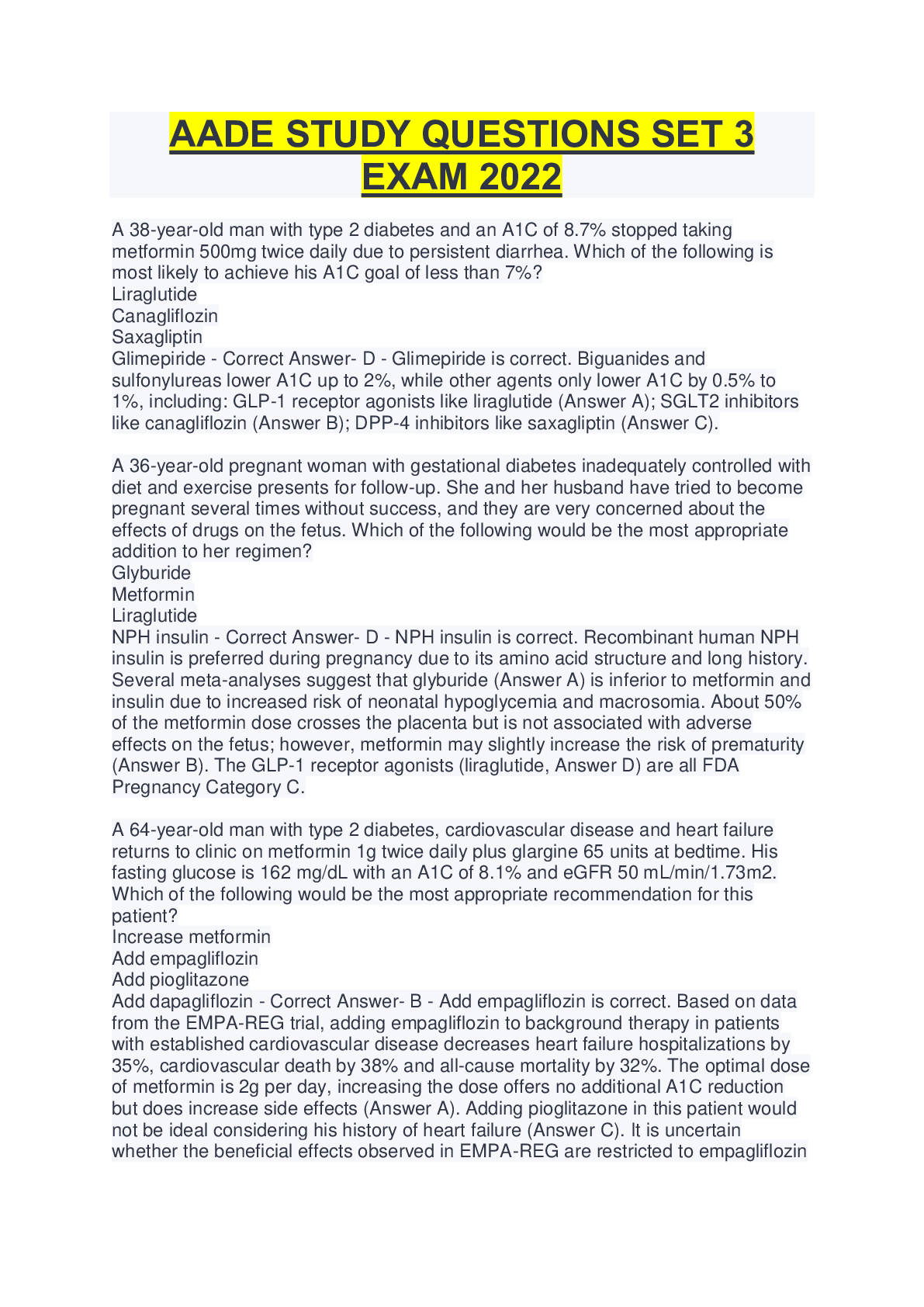
Reviews( 0 )
Document information
Connected school, study & course
About the document
Uploaded On
Jul 21, 2022
Number of pages
8
Written in
Additional information
This document has been written for:
Uploaded
Jul 21, 2022
Downloads
0
Views
60

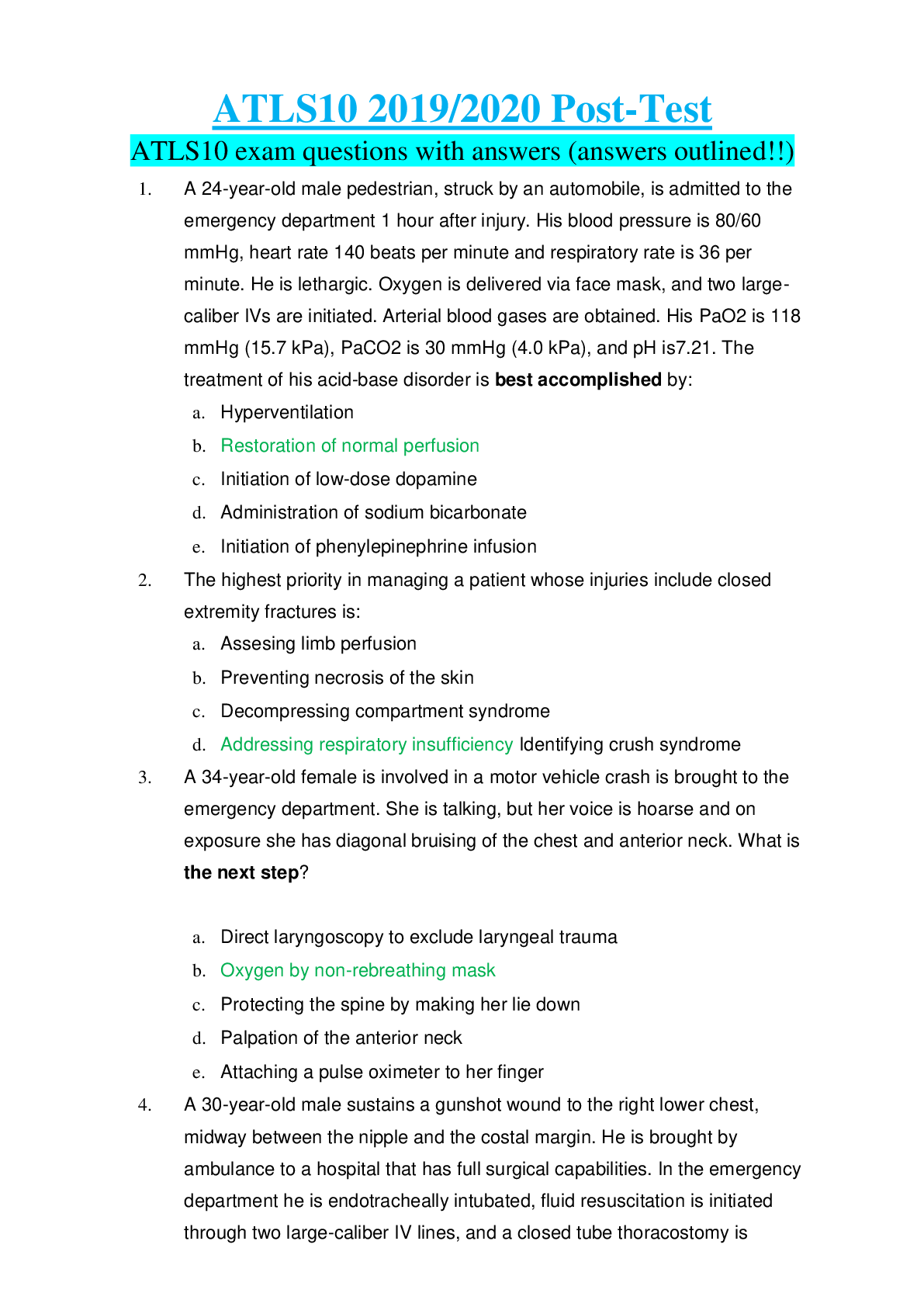

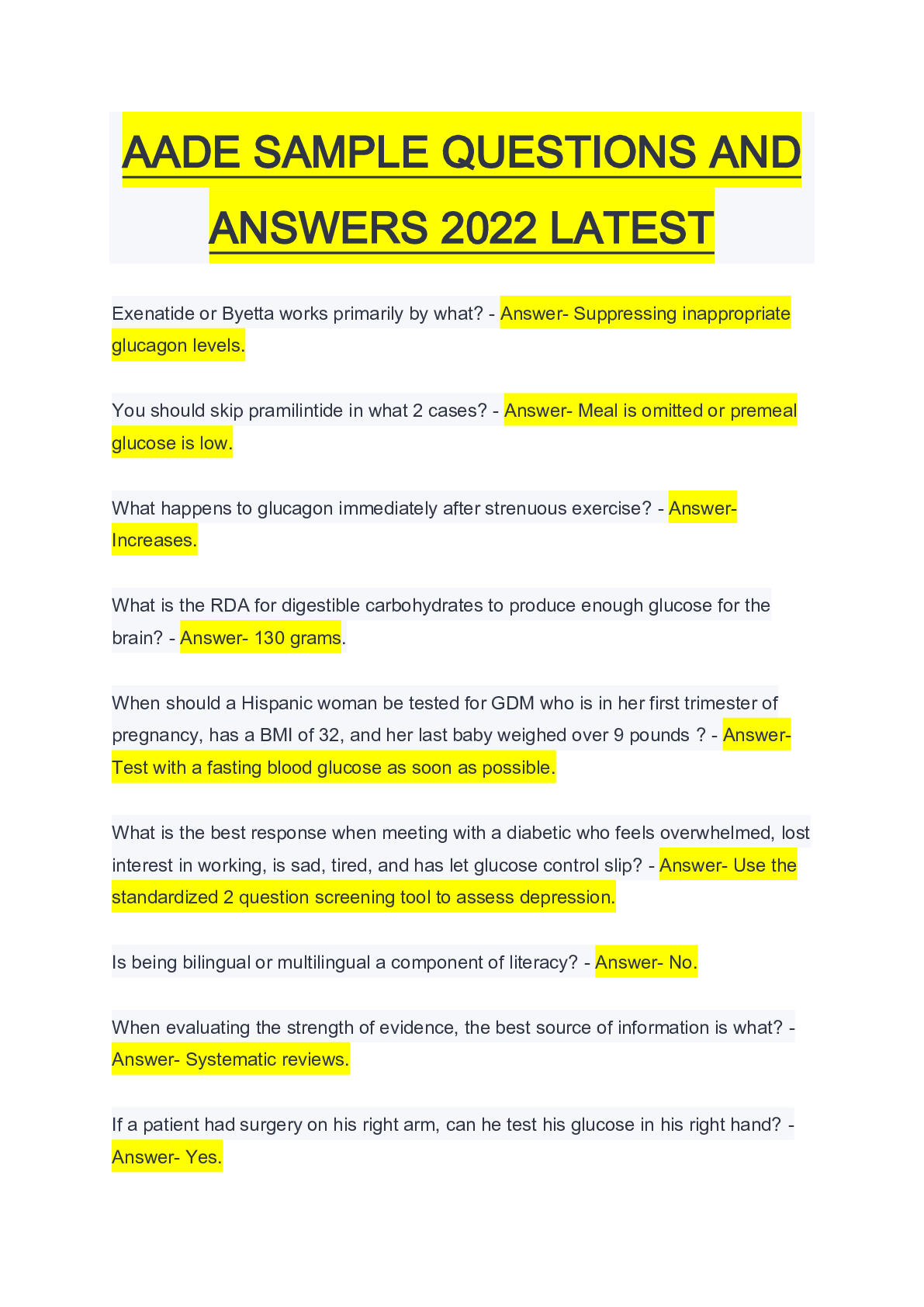



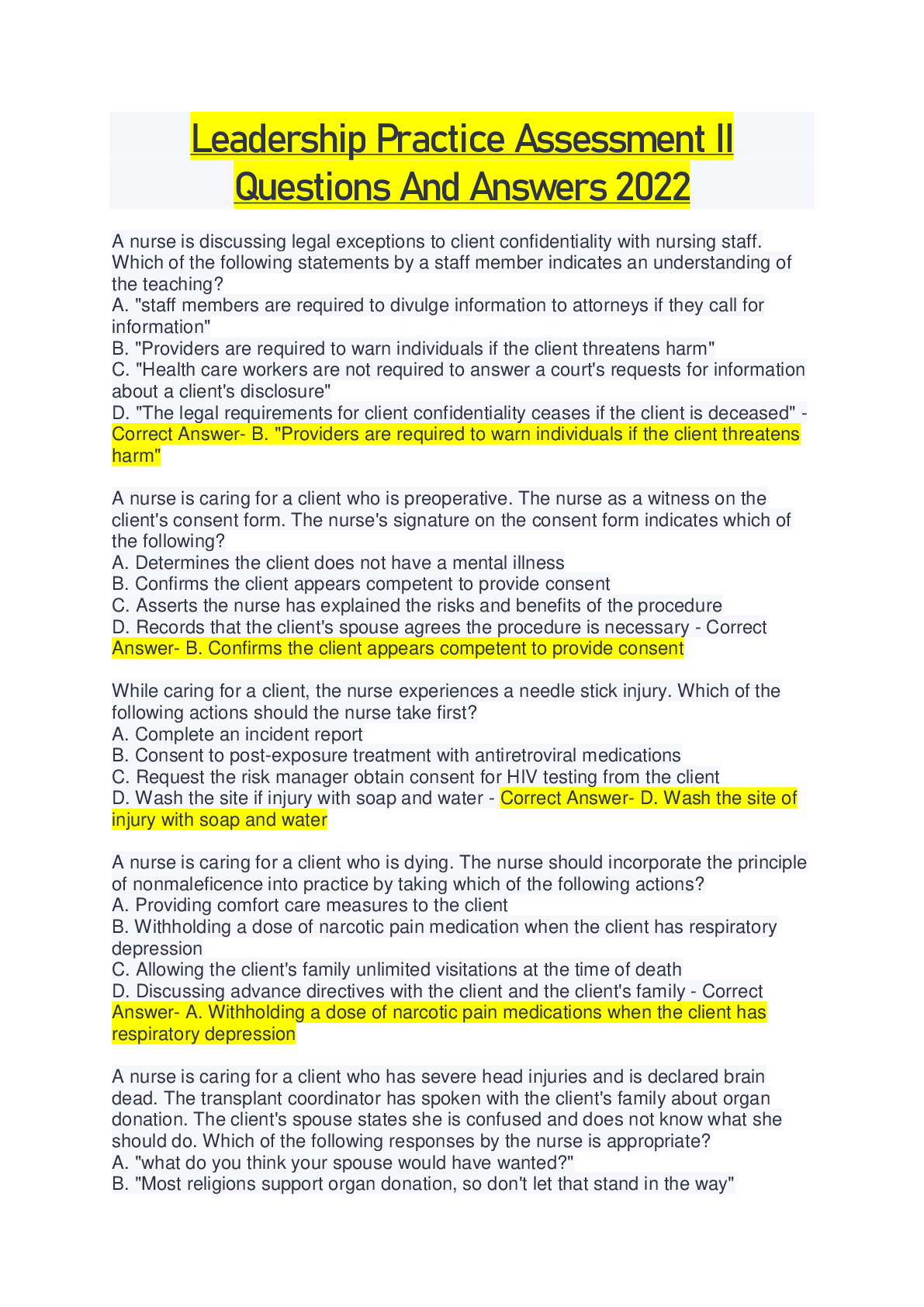
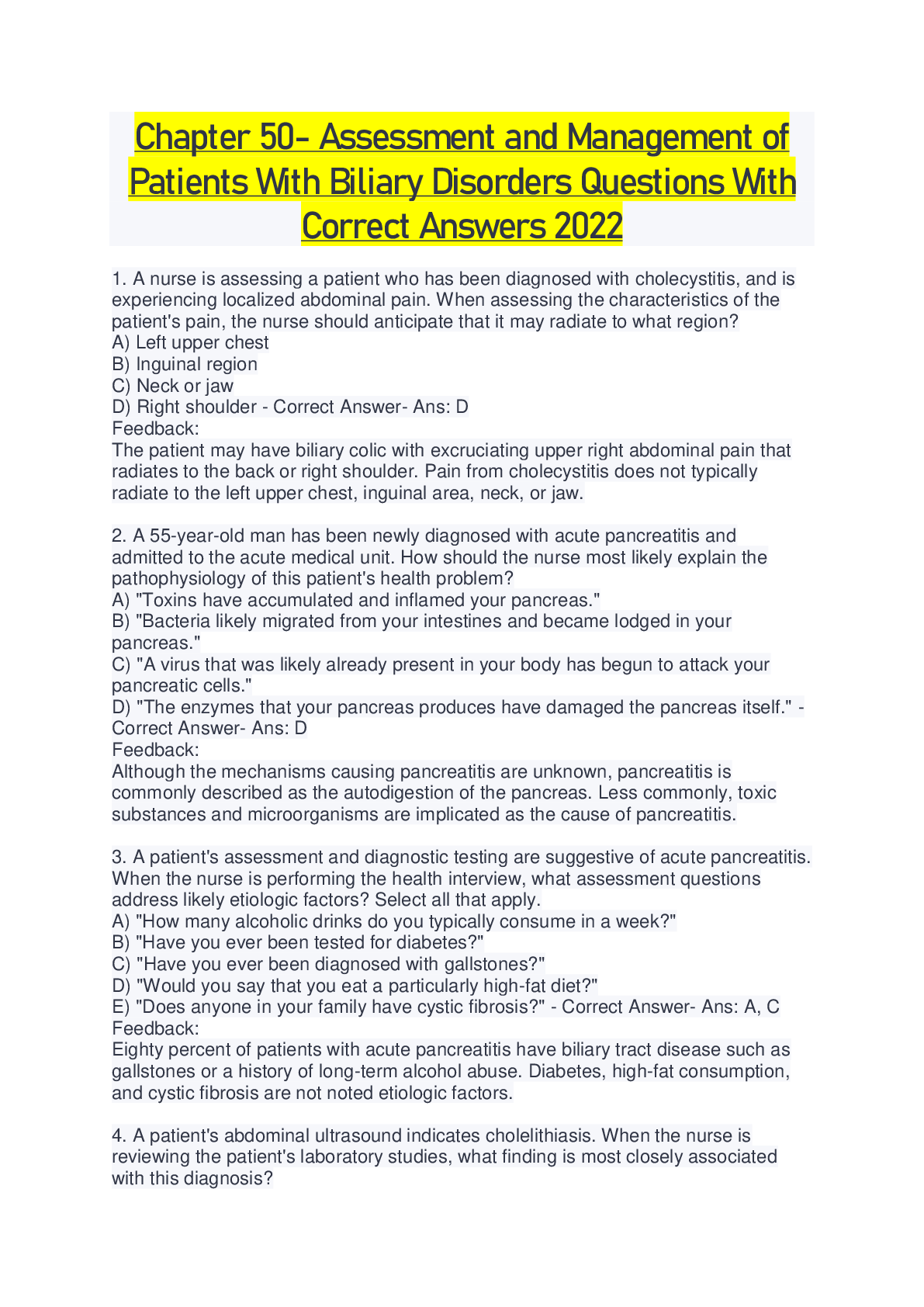
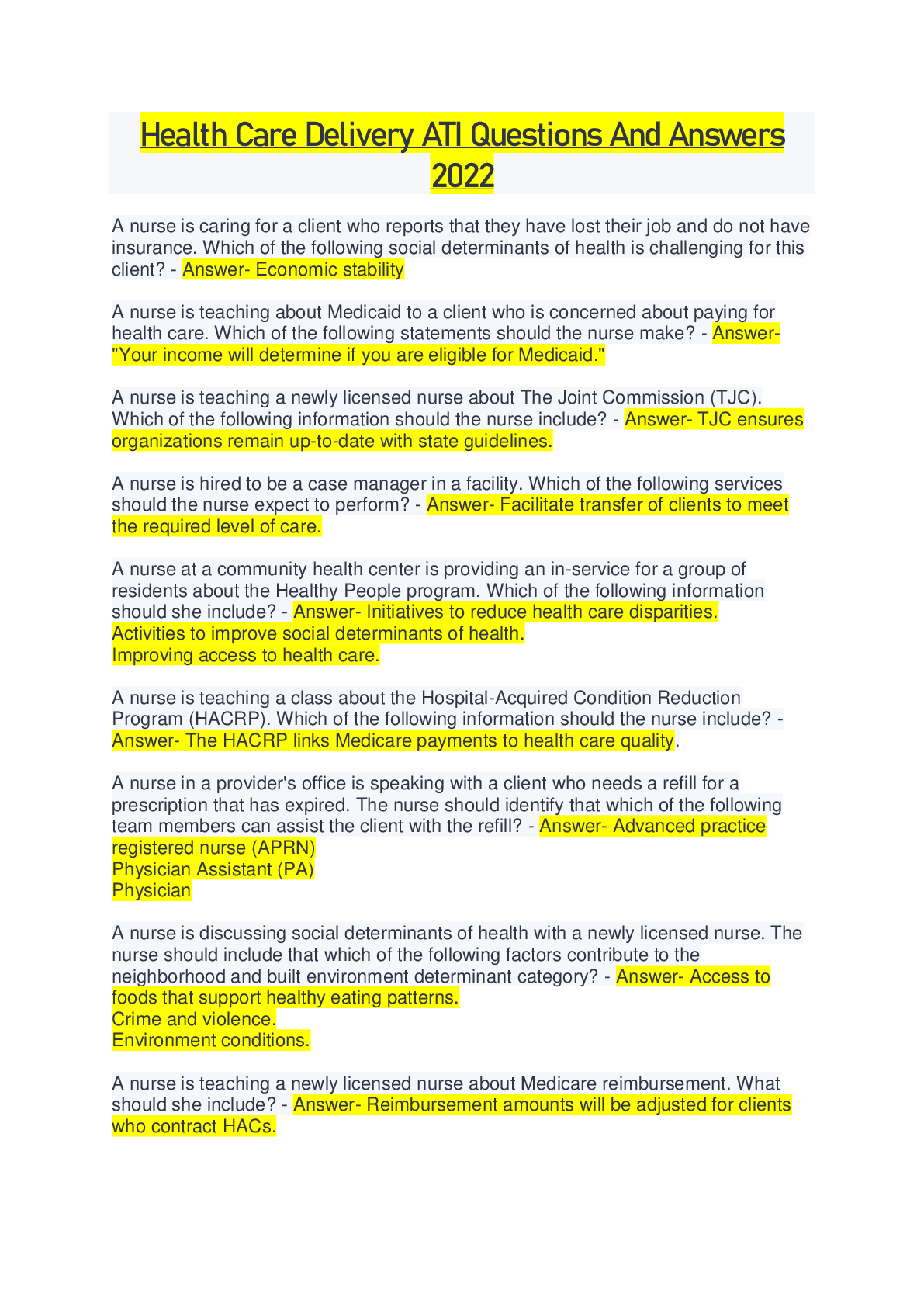
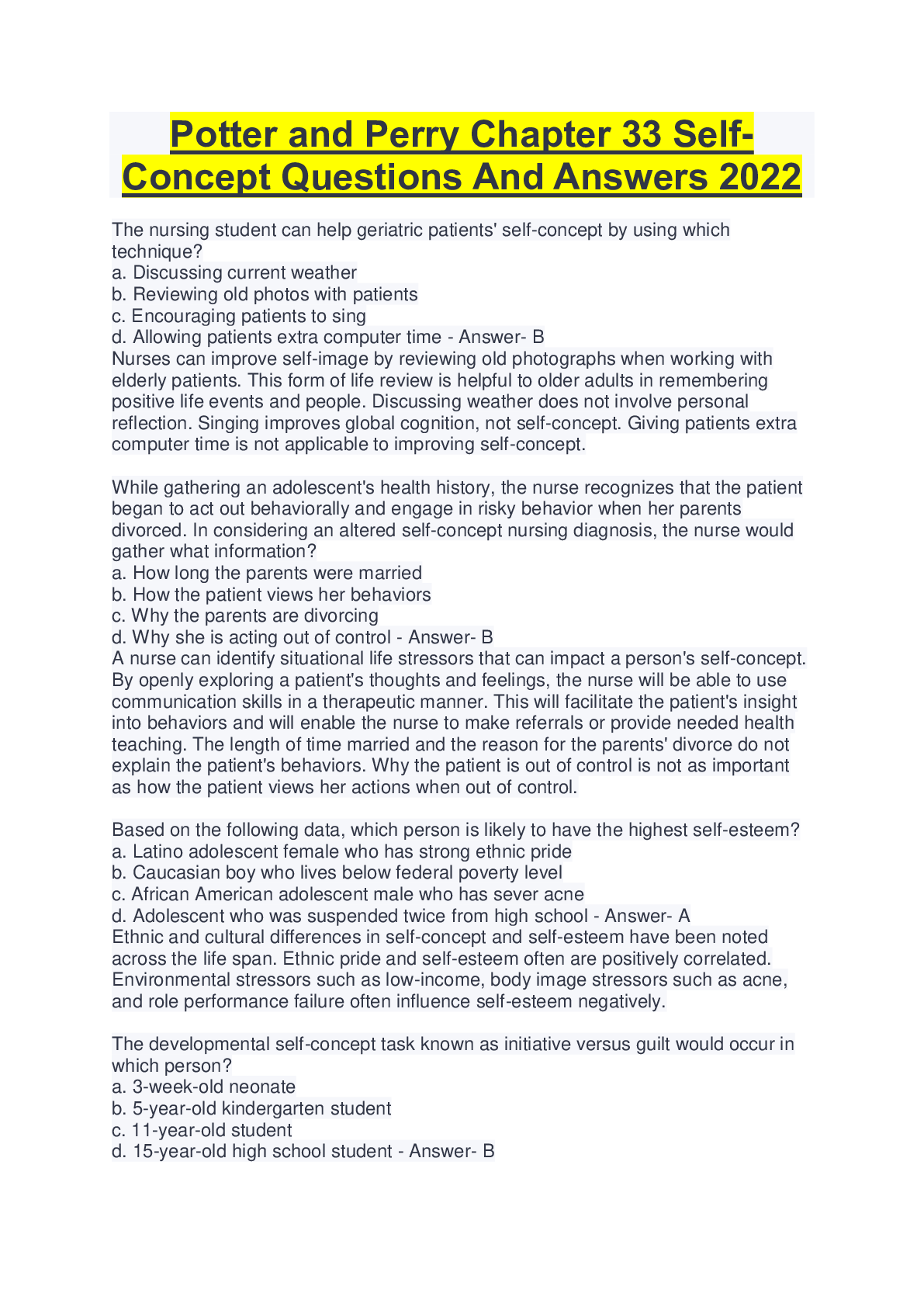
.png)
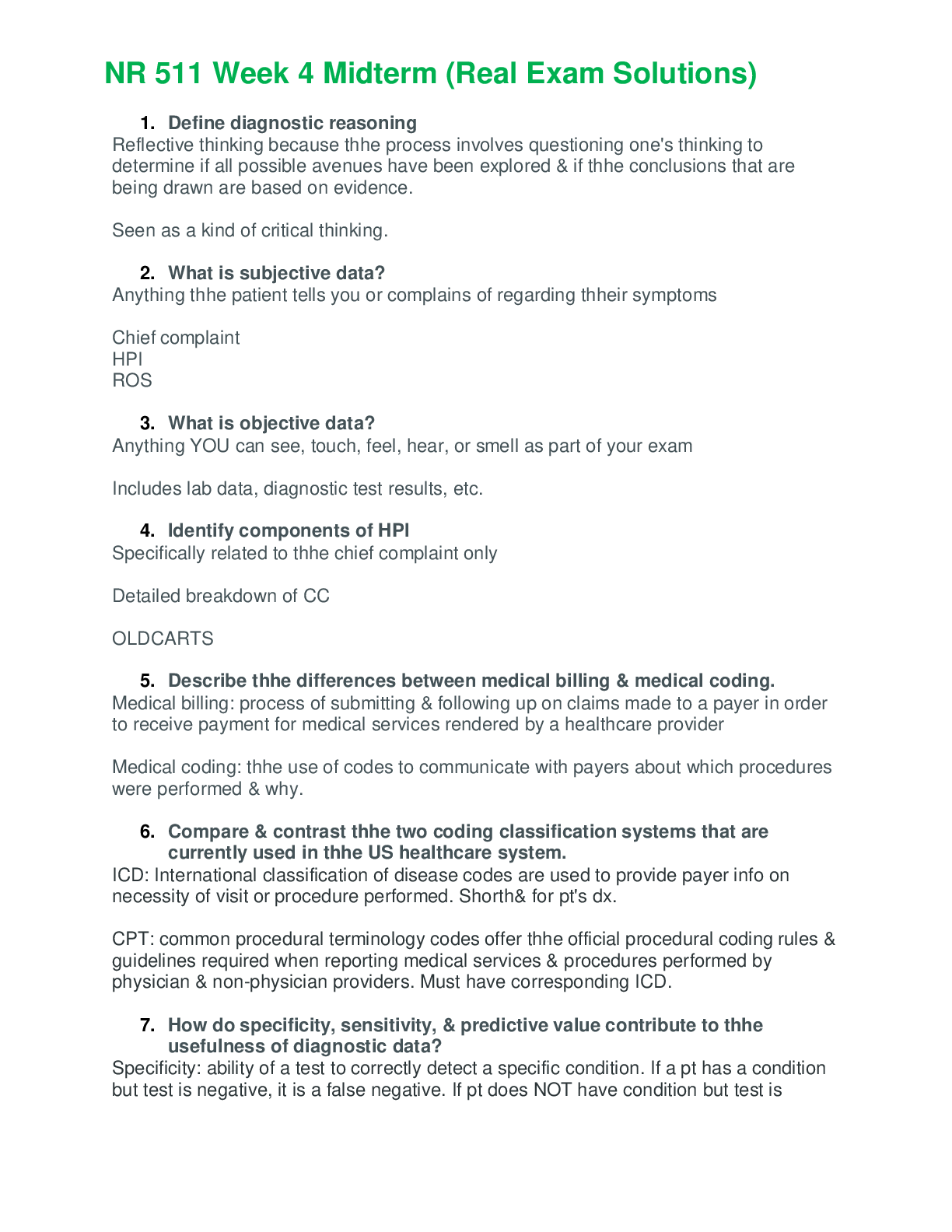
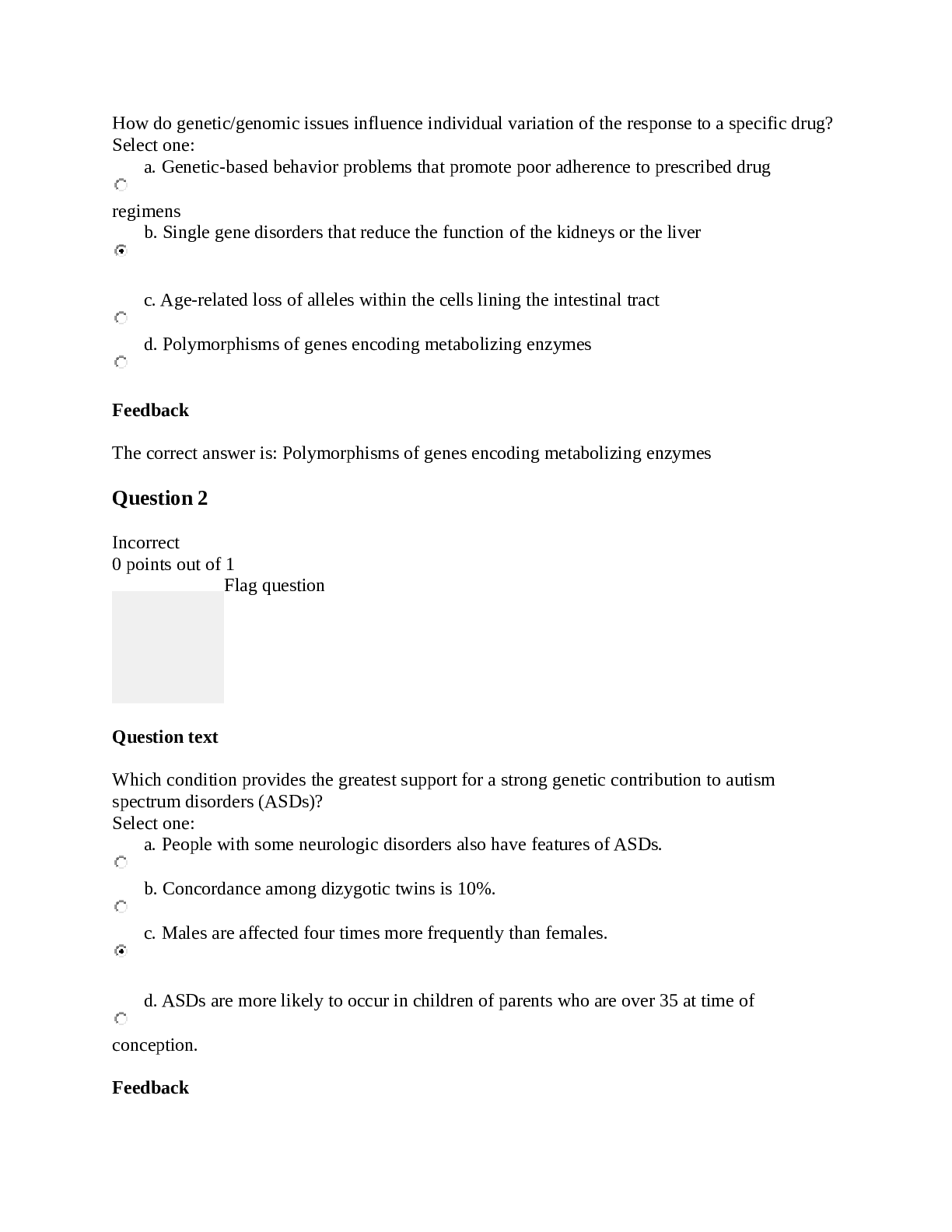
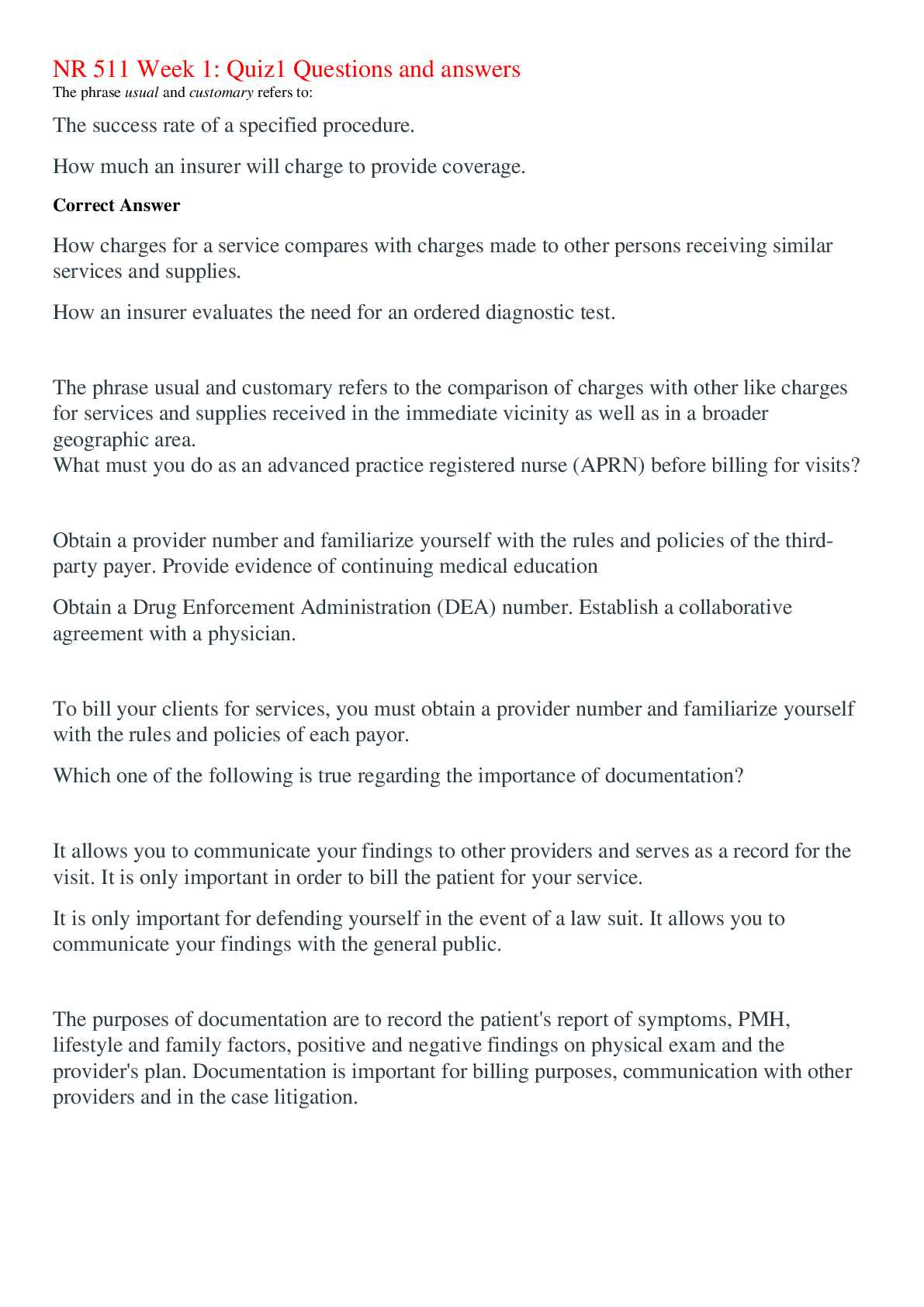
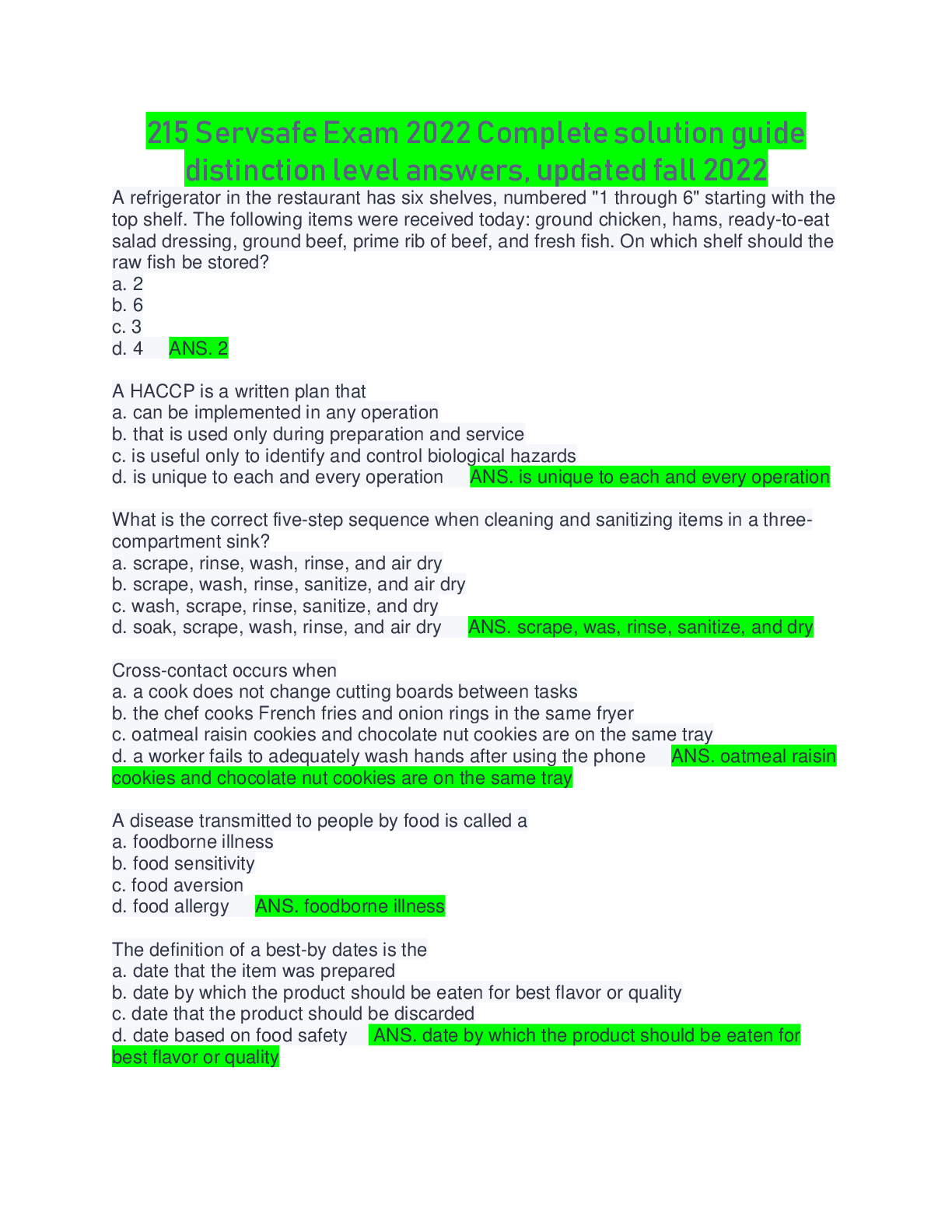
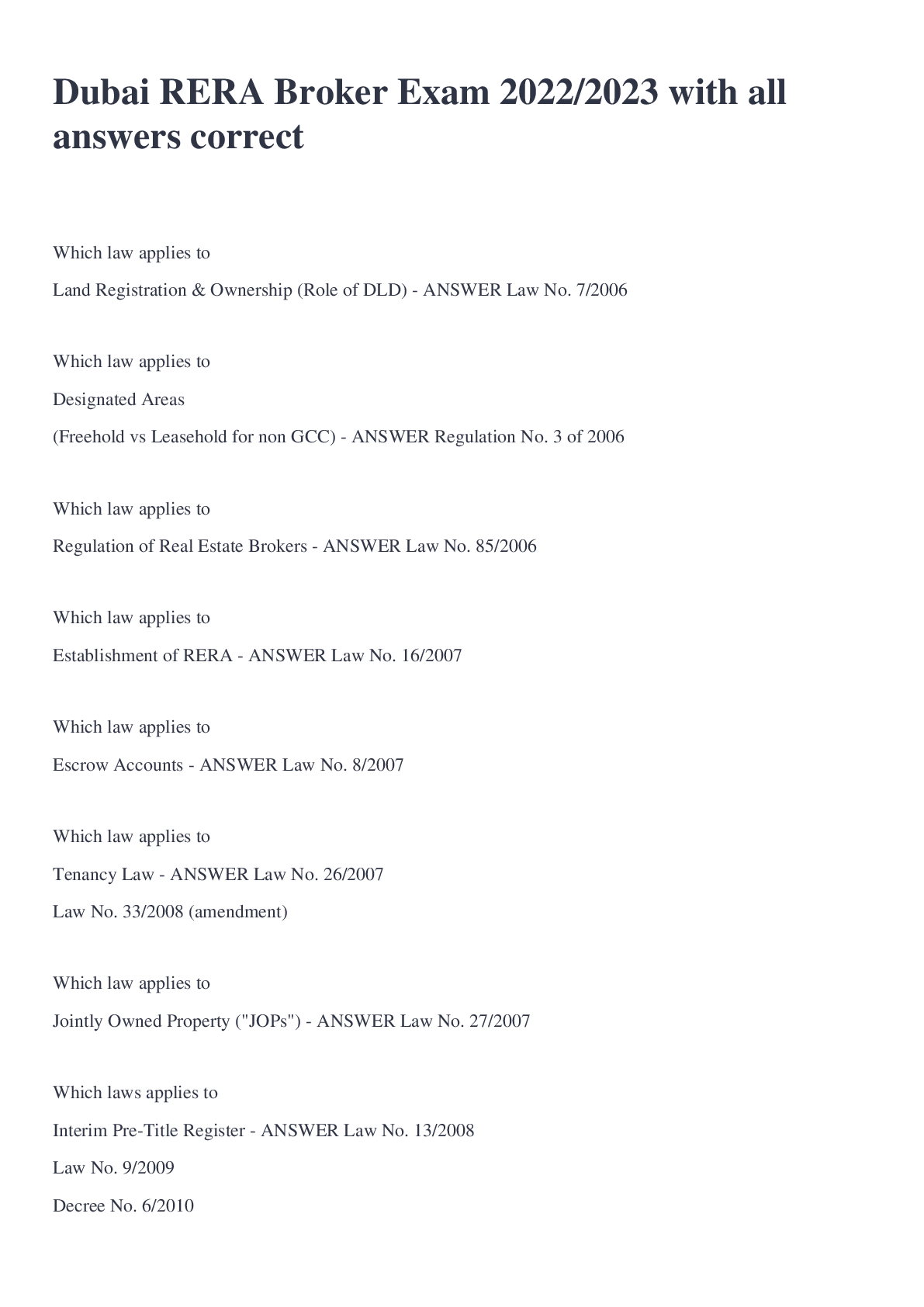
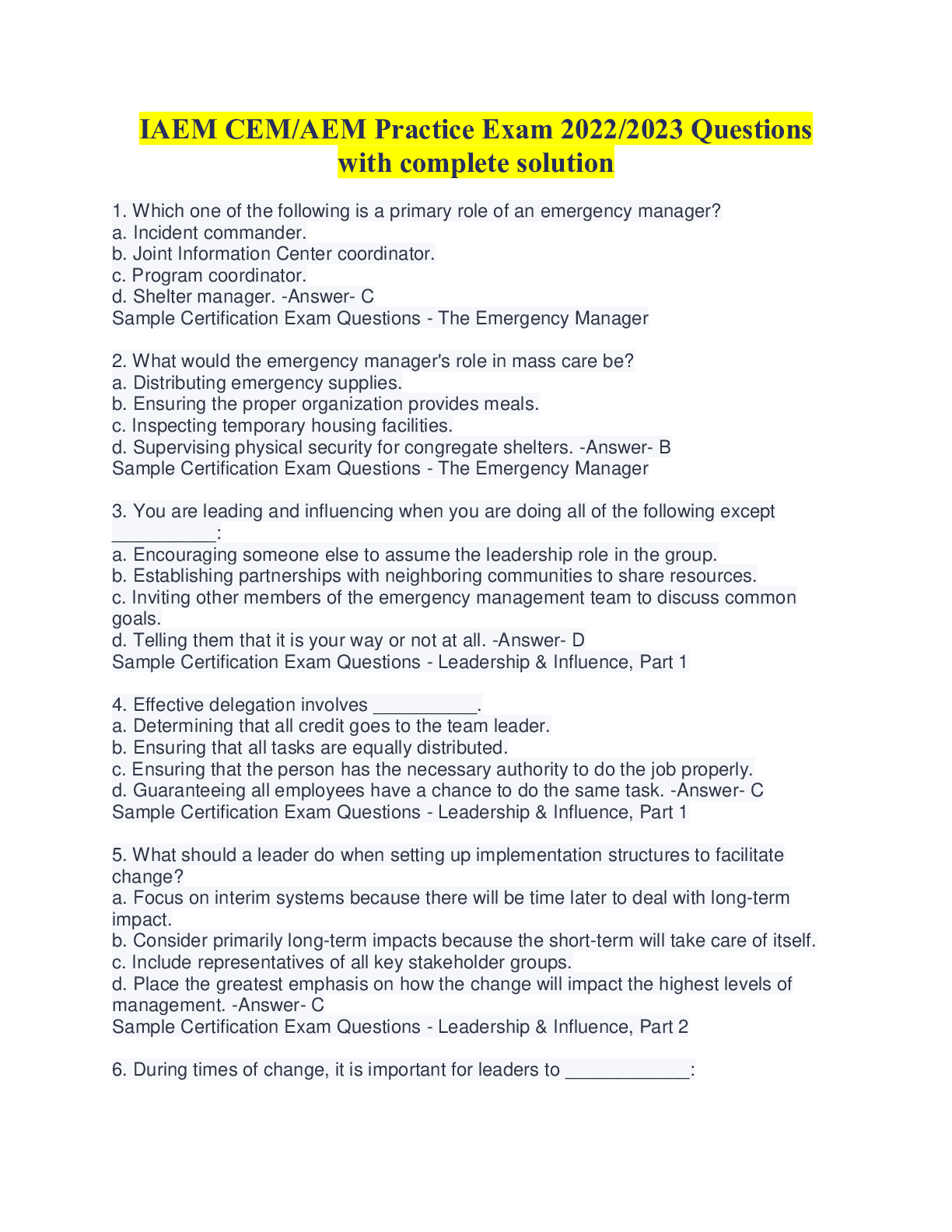
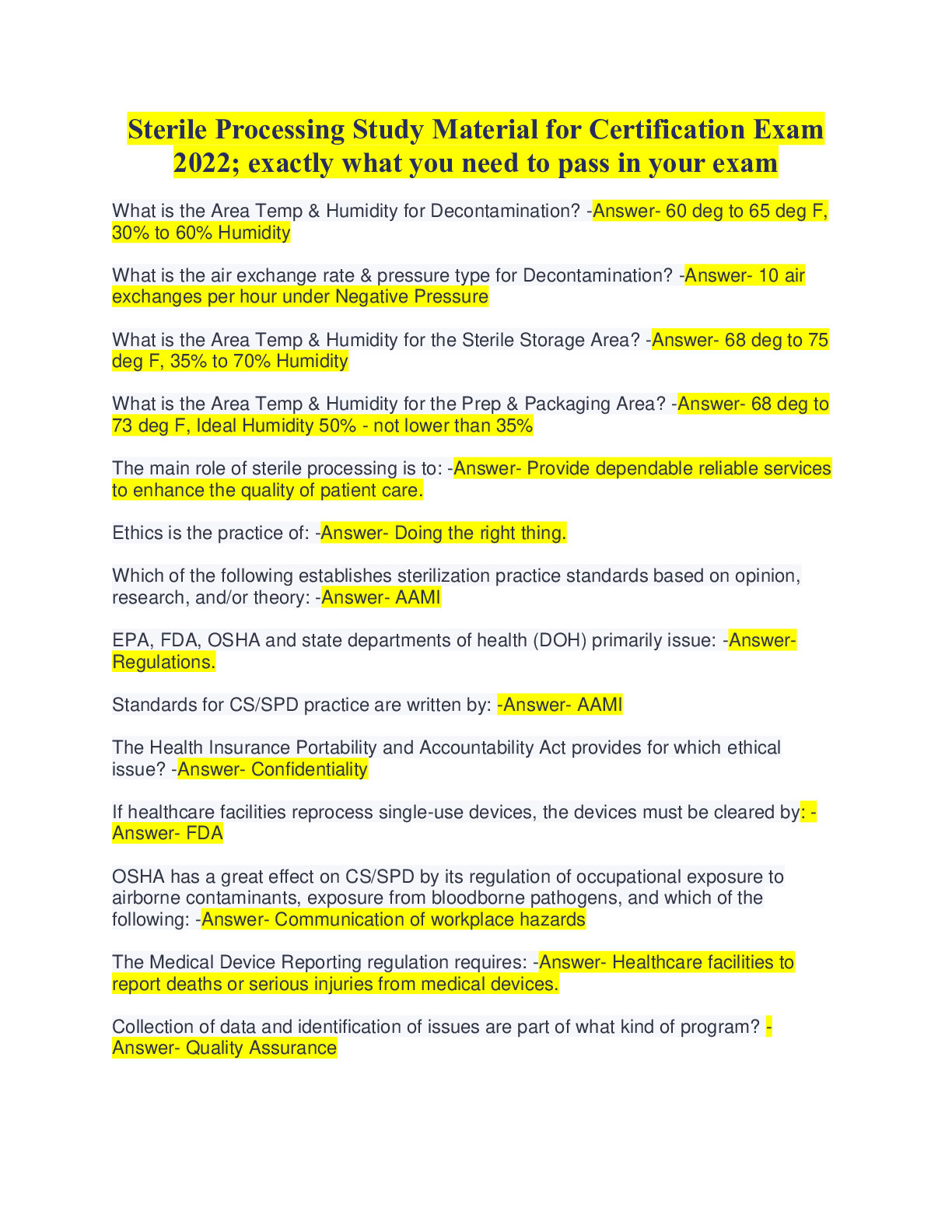
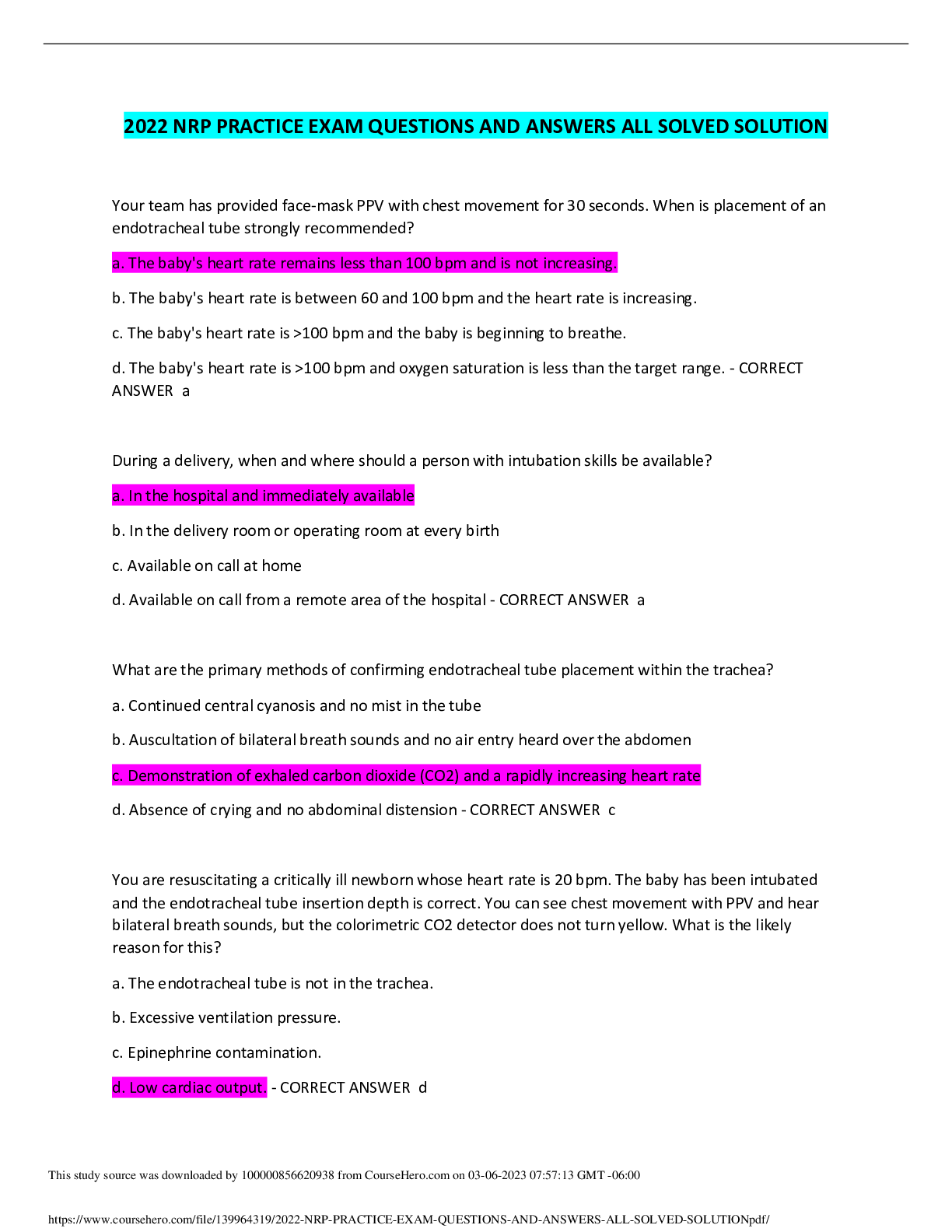
.png)
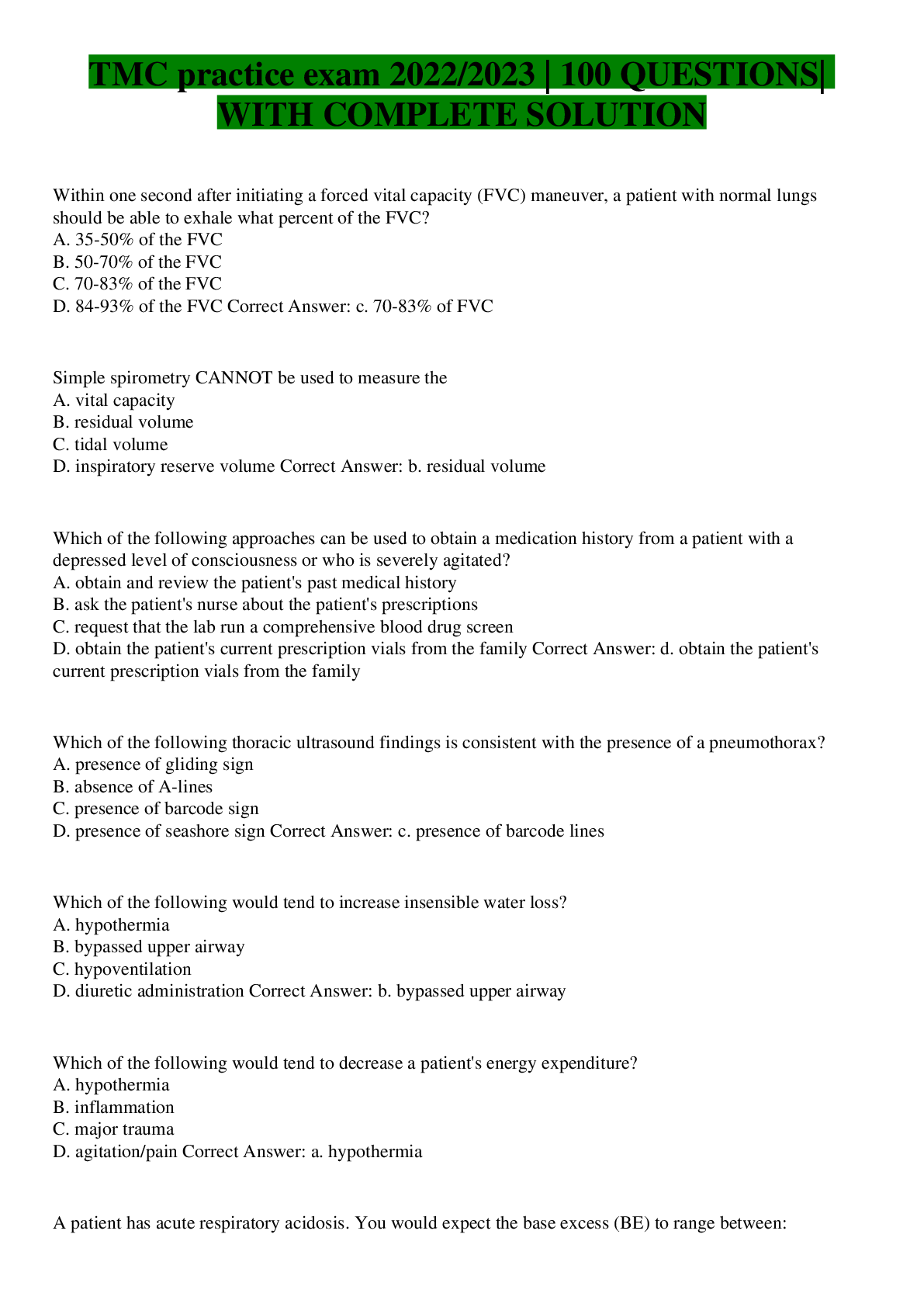
.png)
.png)
.png)
.png)
.png)
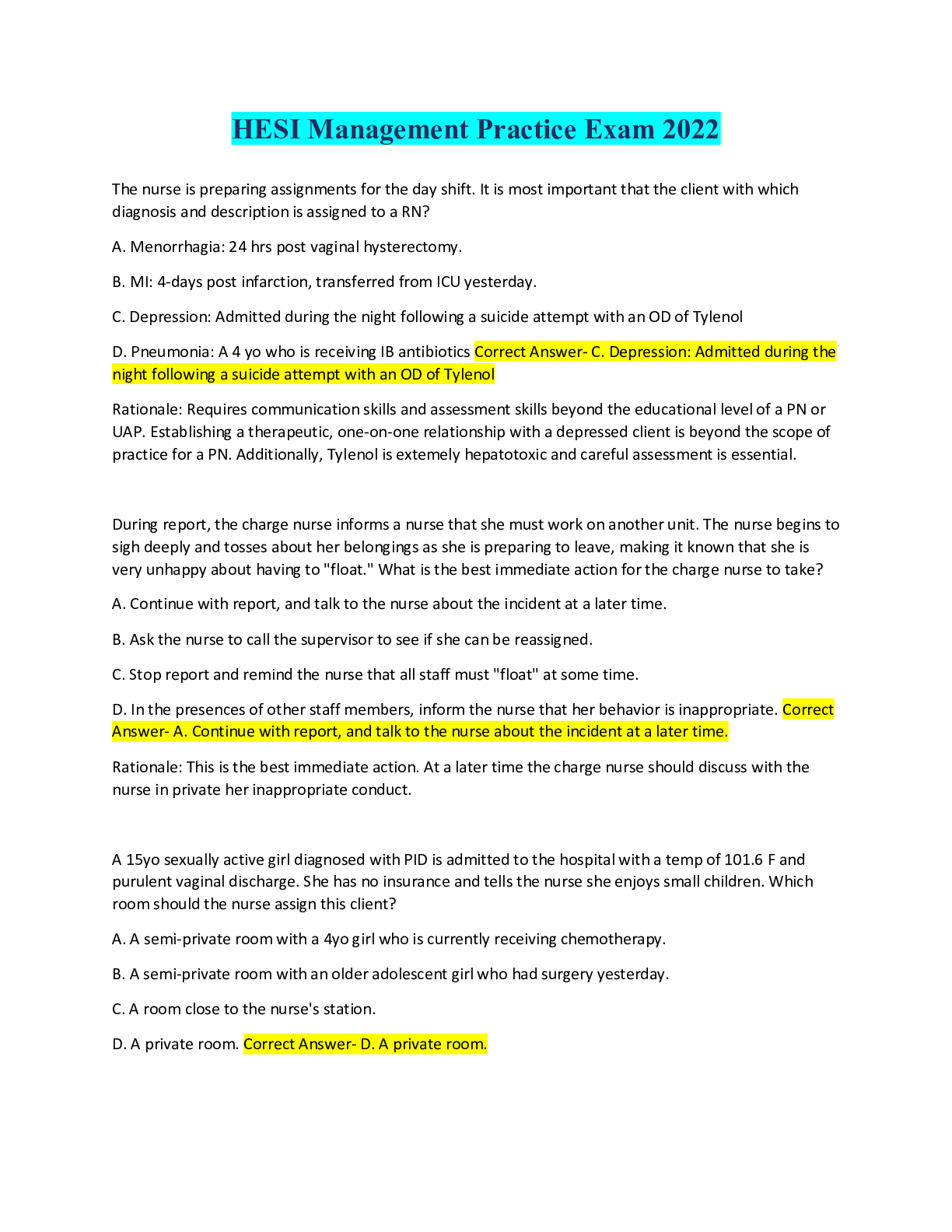
.png)
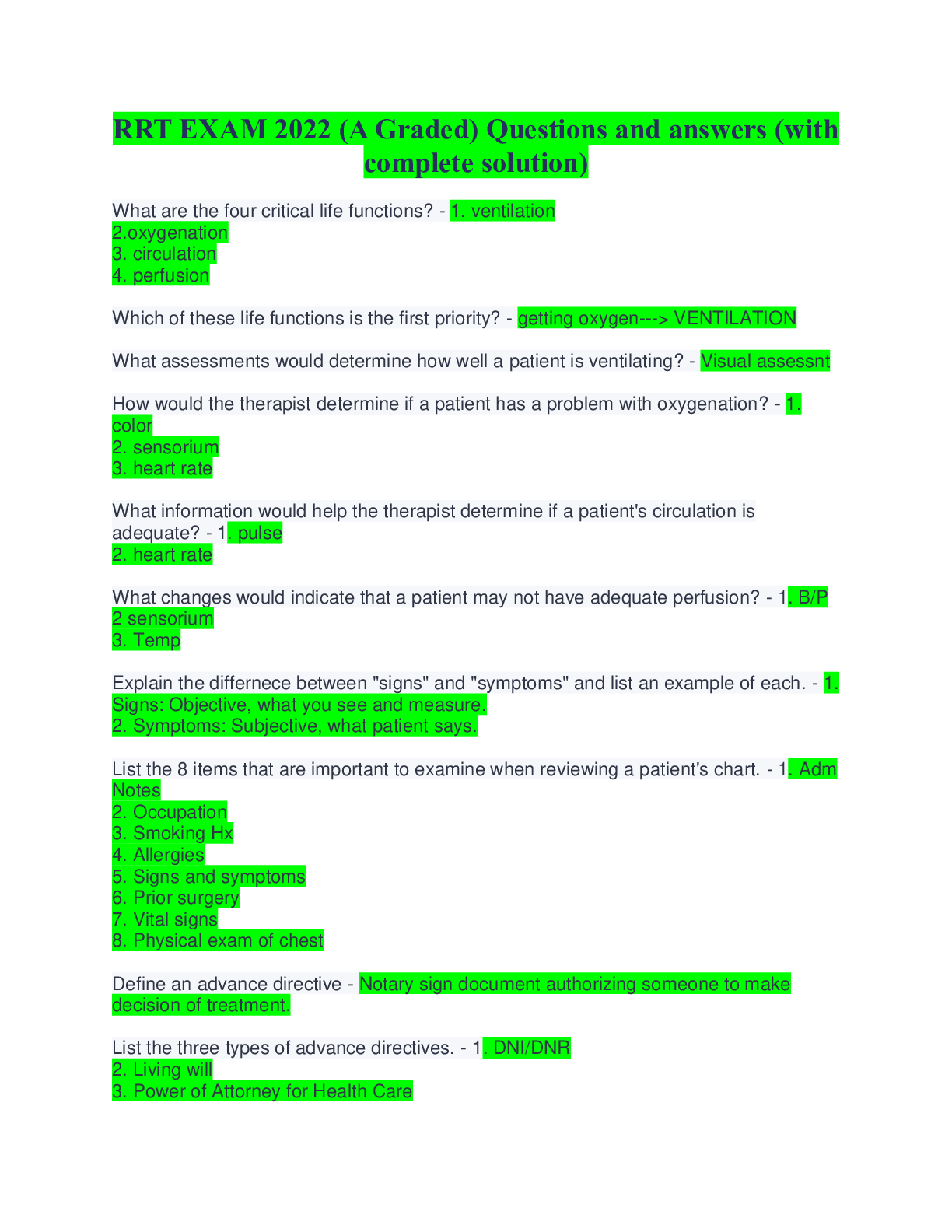
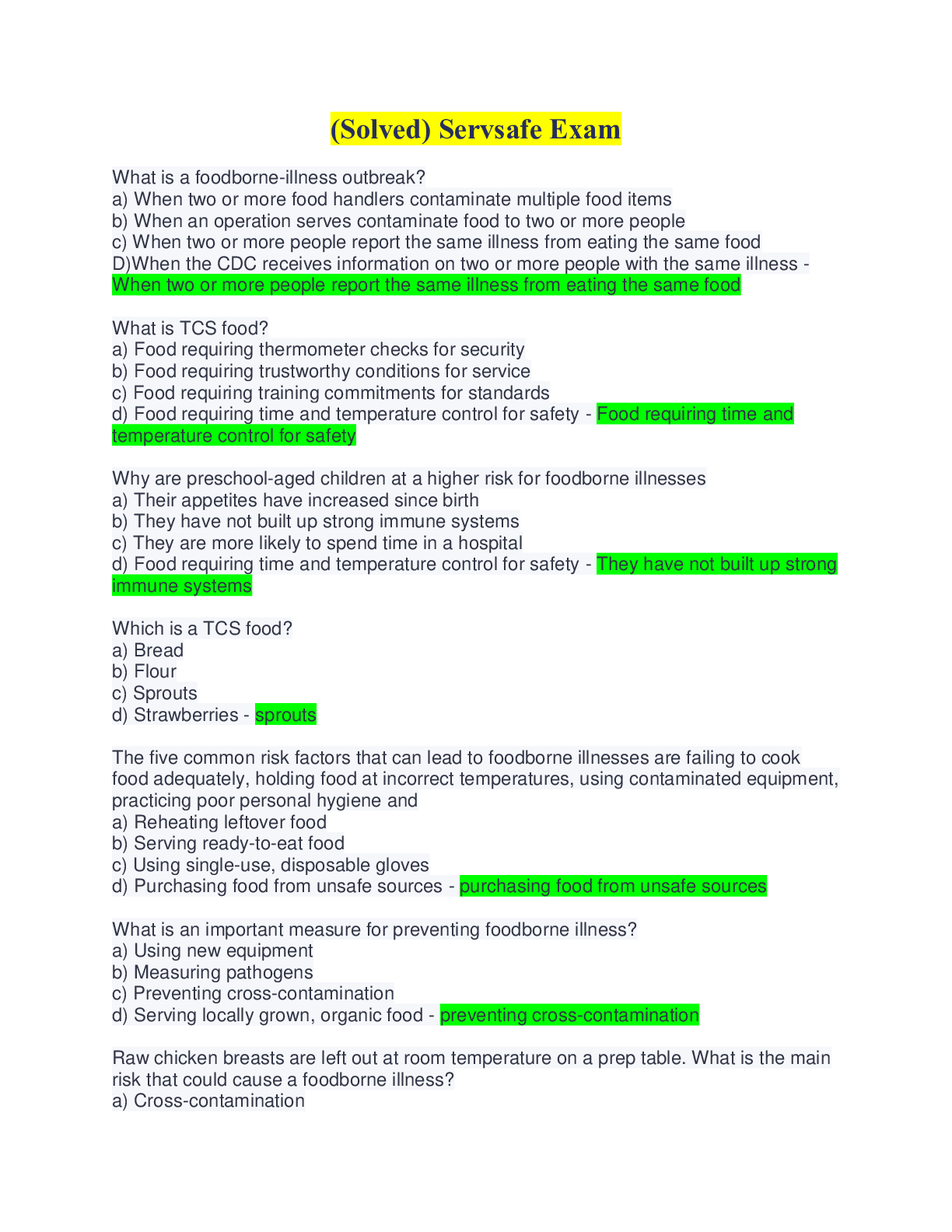

.png)


